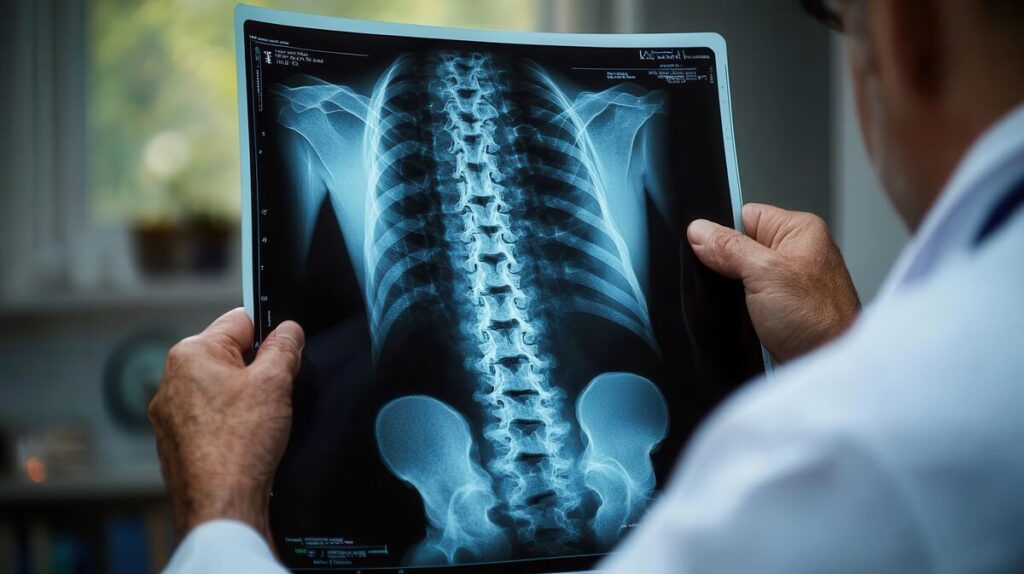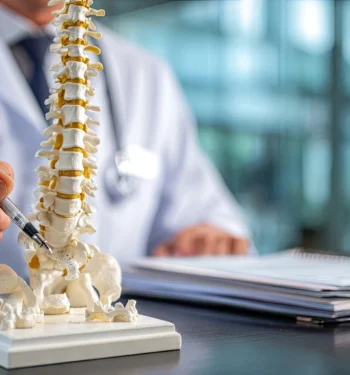
Introduction to Laminectomy and Spinal Decompression
Spinal stenosis occurs when the spinal canal narrows, putting pressure on nerves and causing pain, numbness, or reduced mobility, which can severely impact daily life. When symptoms don’t improve with conservative care, surgery may be needed.
A laminectomy is a type of decompressive surgery (i.e., a procedure that relieves pressure on the spinal cord or nerves) that removes part of the vertebra to relieve this pressure, reducing nerve irritation and improving movement. For those seeking spinal stenosis treatment in Indiana, laminectomies often provide lasting relief and a return to activity. But exactly how serious is spinal decompression surgery?
This blog covers what you need to know — from treatment options to whether a laminectomy for spinal stenosis is right for you — including common questions like, “Is a laminectomy a major surgery?” At Goodman Campbell, we typically recommend laminectomy for spinal stenosis when symptoms are severe, using advanced, minimally invasive techniques to bring about optimal outcomes. Ask your doctor about Goodman Campbell for expert spinal stenosis care and consultation.
What Is the Difference Between Laminectomy and a Decompression Surgery?
Laminectomy is a common surgical procedure used to treat spinal stenosis, a condition in which your spinal canal narrows, placing pressure on nerves and causing pain. Specifically, laminectomy involves removing a portion of the vertebra called the lamina to relieve this compression.
Spinal decompression, meanwhile, refers to a broader set of techniques used to address compressed nerves. It may include laminectomy for spinal stenosis, discectomy (removal of herniated disc material), or other methods based on your individual case.
For patients experiencing severe symptoms of spinal stenosis, laminectomy is one of the most effective treatments available.
What Are the Steps of the Laminectomy Procedure?
Here’s what happens before, during, and after your laminectomy for spinal stenosis:
1. Preoperative Preparation and Anesthesia
Your care team provides presurgery instructions. On surgery day, anesthesia helps keep you pain-free.
2. Surgical Procedure
The laminectomy procedure steps include:
- Incision: A small incision is made over the affected vertebrae.
- Removing the Lamina: The surgeon carefully removes part of the lamina to relieve pressure on the spinal cord or nerves.
- Relief of Nerve Pressure: With the obstruction cleared, nerve irritation is reduced, alleviating pain.
3. Postsurgery Monitoring
How long is laminectomy surgery? Most last 1–2 hours. Afterwards, you’ll be monitored before discharge or rehab.
Goodman Campbell uses minimally invasive techniques to reduce scarring, bleeding, and recovery time.
How Serious Is Spinal Decompression Surgery?
Many patients wonder, Is a laminectomy a major surgery, or How serious is spinal decompression surgery overall? The answers depend on the type of procedure and your health. While risk factors are well managed by experienced Goodman Campbell surgeons, risks do exist.
Potential Risks:
- Infection/bleeding
- Rare nerve damage
- Symptom recurrence
At Goodman Campbell, patient safety is a priority, strengthened by our dedication to using advanced techniques and practicing personalized care. Most patients can expect a short hospital stay with close monitoring for a smooth recovery.
What Is the Success Rate of a Laminectomy for Spinal Stenosis?
Laminectomy for spinal stenosis is highly effective for most patients, with success rates ranging between 85–90% in improving pain and mobility.* Many individuals report significant relief and a return to normal daily activities after recovery.
Expertise matters greatly in achieving these outcomes. Goodman Campbell’s leading-edge surgical procedures and personalized aftercare make a significant difference in both patient satisfaction and the overall success rate of laminectomy.
How Long Does it Take to Recover From a Decompression Laminectomy?
Decompression laminectomy recovery varies, but here’s what to expect:
- Initial Recovery
- Varies from an outpatient procedure to a hospital stay: 1–3 days for monitoring.
- Pain management: Medication controls discomfort.
- At-Home Recovery
- Most regain mobility over six weeks.
- Light walking is encouraged; avoid heavy lifting or twisting.
- For L4-L5 laminectomy, return to activity varies by age and health.
- Long-Term Care
- Full recovery takes 3–6 months, but can vary by patient.
- Physical therapy may aid strength and flexibility.
- Understanding the long-term effects of lumbar laminectomy is key; while many see lasting relief, outcomes vary.
Goodman Campbell offers personalized recovery plans to improve your quality of life. Ask your doctor about expectations and how Goodman Campbell can support your healing.
What Is the Downside of Laminectomy?
While most patients see significant benefits, it’s important to be aware of potential downsides to consider:
- Possible Laminectomy Complications:
- While rare, complications such as infection and nerve injury can occur.
- Possible Long-Term Effects of Lumbar Laminectomy
- There’s a small chance of spinal instability or recurring symptoms, sometimes requiring additional procedures like spinal fusion.
Choosing a skilled back and spine care team, such as the neurosurgeons at Goodman Campbell, significantly reduces these risks. If you’re concerned about laminectomy complications or long-term effects, consult your doctor about how Goodman Campbell can help.
Conclusions and Next Steps
Deciding to undergo spinal surgery is no small decision. However, laminectomy for spinal stenosis has been shown to effectively relieve pain, restore movement, and improve quality of life, making it a viable option for many patients.
At Goodman Campbell, we provide world-class back and spine care tailored to your needs — from diagnosis and treatment to recovery and rehabilitation. If you’re exploring spinal stenosis treatment in Indiana, ask your doctor about Goodman Campbell. Our team helps you get back to the activities and life you love.
To learn more or schedule a consultation, visit GoodmanCampbell.com or contact us — we’re here to guide you every step of the way.
*Haddadi K, Ganjeh Qazvini HR. Outcome after Surgery of Lumbar Spinal Stenosis: A Randomized Comparison of Bilateral Laminotomy, Trumpet Laminectomy, and Conventional Laminectomy. Front Surg. 2016 Apr 8;3:19. doi: 10.3389/fsurg.2016.00019. PMID: 27092304; PMCID: PMC4824790.


